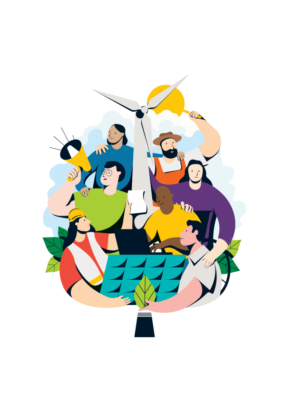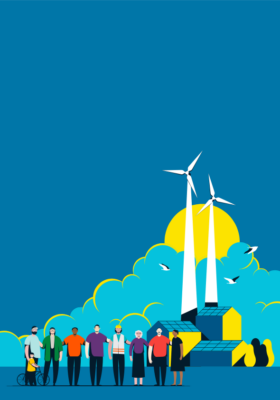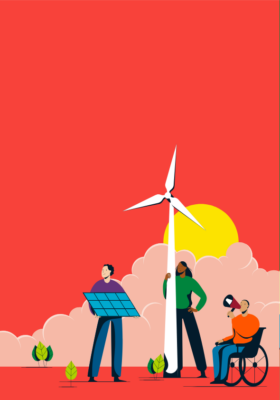“Community is the spirit, the guiding light of the tribe, whereby people come together in order to fulfil a specific purpose, to help others fulfil their purpose, and to take care of one another. The goal of the community is to make sure that each member of the community is heard and is properly giving the gifts that they have brought to this world. Without this giving, the community dies. And without the community, the individual is left without a place where they can contribute. And so the community is that grounding place where people come and share their gifts and receive from others.”
― Sobonfu Somé, The spirit of intimacy: ancient teachings in the ways of relationships
You can’t do this challenging work alone. You need more people. With a dedicated group of people – a core team, you can pool together diverse skills, knowledge, and resources necessary for planning, outreach, fundraising, and managing your renewable energy project to win. The core team provides the backbone for your work, ensuring that everyone is aligned with the goals, coordinating efforts, and sustaining momentum throughout the project.
A core team is a group of people who can meet locally and regularly to move your chosen project through. Local scale means you can meet face to face as a group, and work to change the institutions within your immediate reach: whether that’s your neighbourhood, village, town or city.
When building your core team, you’ll want people with a range of diverse and complementary skills and experiences, with a commitment to do the hard work to achieve your goals, and a curiosity to learn and grow.
As you start setting up your group, invite people who will bring commitment and curiosity. Most local groups start out with a minimum of 3 people (depending on your goal you may have a much bigger team!).
Ensure that your team shares the same goal and is guided by core values
Our goal is simple: building renewable energy projects, like solar panels and wind turbines, that are led by the communities.
Make sure everyone is behind this goal and ready to focus on this big challenge! The shared goal is the cornerstone of any effective teamwork. It provides direction, motivation, and a sense of unity, which are all essential for your team’s success.
When working towards a common goal, there is less room for conflicting priorities and more clarity on what the team is trying to accomplish (why we are working together) and the needs to reach its success (what each team member can contribute in terms of skills, knowledge, experience, resources).
As important as having clear goals is knowing what values guide our collective and collaborative efforts. Core values provide a framework for team behaviour, decision-making, and interaction. They help create a strong, cohesive, and principled team that is better equipped to navigate challenges and achieve its goals. The reason why you’ll want to find people who overlap on the core values of your project:
| We are a global movement of citizens working to address the climate crisis. We are global citizens organising to transform our local communities. Working in solidarity across languages and continents, we form a powerful worldwide network united by our common humanity and our commitment to solving the climate crisis. We strive to build an inclusive and empowering movement. From the local to the international, we are open and receptive to new ideas and initiatives, foster broad participation and collective decision-making at all levels of organising processes, and empower new leaders. From faith groups to business leaders to schools and more, we work with a diversity of groups and individuals because we urgently need everybody’s ideas and commitment to create the change we need. The relationships we build with one another and partner groups; the leadership we grow; and the stories we tell are all part of building our people power – this is key to how we create change. We work across movements, with justice at the core. We recognise the linkages between issues of climate justice, economic justice, racial justice, gender equality, workers rights and more, and strive to build a movement that works in common cause with allies for shared impact. We stand in solidarity with communities most impacted by climate change and fossil fuels. Many of these communities are the least protected from climate change, due to historical inequalities, and the most impacted by it. We support their demands for their survival, and the rights of future generations. We are committed to real action, not just talk. We’re built on collective brilliance, not on individual personalities. There’s no place for ego in organising, and we say “yes” as much as possible (while respecting our limits). We strive to stay flexible, nimble and to do a lot with few resources, so we can focus on taking action to serve our communities. We think and act to scale with the problem. Thinking big and being ambitious is how we inspire people to get involved and act with the necessary urgency. Creativity is the touchstone of our work. Through symbols, art and creative actions, we help visualise both the problems and the solutions to climate change. Creative ways of communicating often speak more directly to our hearts, and provide a beautiful reminder of what we strive to protect. As organisers, we connect with the heart and soul as much as we connect with the brain. The climate crisis is an ethical issue; taking action in a meaningful way brings moral weight to our work and deepens our commitment to the cause and each other. Through this connection we are better able to cope with our dramatically changing planet, and imagine the world we want to build. Any movement that isn’t fun isn’t worth being a part of. We dance, sing, eat, play and tell jokes together because it lifts our spirit, gives us hope, and keeps us motivated for the many challenges (and victories) ahead of us on the road to a sustainable, clean energy future. We creatively use technology to support organising in the real world. We realise technology is not a replacement for real relationships or time-tested organising techniques, but it allows us to see, understand and act in solidarity with our brothers and sisters facing climate change around the world; we are a community linked by technology. We’re not experts, but we know enough about the climate crisis and the fossil fuel industry to speak the truth. We keep up with the science, economics, and the politics as best we can, but we also know we don’t need to know every bit of information to stand up for our future. Speaking the truth on science and injustice is both our responsibility and our most effective strategy. While science is important, stories make our movement powerful and human. We all have our own compelling stories, and communicate with stories to gain mass media coverage, to multiply our movement, and to reaffirm our common humanity. Whether it’s a lone brave protester in Iraq or a community coming together to stop a coal plant in Kenya or fracking in Brazil, shared stories inspire our movement. We use non-violent means to achieve change. We are committed to nonviolence, inspired by the spirit of Gandhi, Martin Luther King Jr., and other peaceful movements before us. No violence, no property damage. In the face of the climate crisis, fossil fuel extraction, and the repressive practices of the governments and corporations that benefit, we recognize strategic nonviolence as the most effective means of creating a just and healthy world. |
Many people may join for multiple reasons — they want a just energy transition or they want to take on the fossil fuel industry (Why fossil fuel pollution is bad or The power of the fossil fuel industry). And they may join for reasons far away from climate — saving money, community control and power, distrust of big corporations…
Aligning with a common set of values ensures that everyone is working towards the same goals and it is crucial for achieving a unified vision no matter what was their initial motivation to join. It helps the team to make choices that are consistent with its core values, even in complex or ambiguous situations, and creates a stronger sense of teamwork.

Where do you find more people?
If you’re alone, finding your core team may take some time. You might look for people by reaching out to organisations to find partners:
- Asking 350 or other climate groups for local contacts in the area
- Organisations working on related issues (renewable energy, energy poverty, energy democracy, energy transition)
- Local environmental or climate justice organisations
- Universities, colleges, and high schools
- Local grassroots groups and nonprofits
- Places of worship
- Labour organisations and unions
- Public housing organisations
- Neighbourhood groups
- Finding neighbours, especially if you have a specific community in mind
- Posting “are you interested” signs on coffee shops and local businesses
- Looking on social media for people who have shown interest in the subject in your region
- Ask a local friendly journalist — they often know who is active on an issue.
One way to spark interest is to consider hosting an event — such as a movie screening or potluck. Make sure to circulate a sign-in sheet to get people’s contact information for following up. This is a good way to get a feel for people and see who you “jive” with — and all of the people can be followed up with in the future for your work.
Other ideas:
- Invite a special speaker (such as a group who has succeeded in building a renewable energy project or some topic related to climate justice);
- Organise a webinar on energy justice or how to replace the fossil fuel industry with renewable energy projects
- Invite people to collectively go through an online course on Climate Change Science 101
What kind of team do we want to be?
It will be important for you to create a core team that is the kind of warm, welcoming team that you want to work with. Consider the following three sorts of leadership structures for a group.
 “I’m the leader” Dependent |  “We don’t have leaders” Structureless |  “A leadership team” Interdependent |
We have found that when people share clear leadership roles and responsibilities in an interdependent leadership team, groups are more likely to grow over time and to be effective. The models of “I’m the leader” or “We don’t have leaders” may work for a short period, but their stability and potential for growth is limited.
We recommend an interdependent team model.
We recommend that a “core” leadership team be responsible for:
- Group hosting: convening meetings of the group of organisers, ensuring that roles and decision-making is clear and that everyone feels included.
- Helping your group come up with clear goals, a strategy, and a plan that everyone has a role in. And regularly evaluate progress against the plan.
- Identifying spokespeople and key messages – especially for media work.
Working groups – smaller teams within your larger group – may form organically as your group evolves, based on the interests and skills of the people in your group.
The core leadership team helps all those sub-groups stay connected and coordinated. In the early stages, stay flexible and adaptable as you learn and experiment – some sub-groups might thrive, others might fail, and that’s OK!
Your role as leaders

In Interdependent leadership, leaders accept responsibility for the functioning of a “whole” (a whole team, a whole project, a whole job) while other organisers accept responsibility for a “part” of the work.
Leaders help others find (or create!) roles and working groups with real responsibility and purpose, where people feel purposeful – like they can make a difference, by contributing to the work of the whole.
Your group’s structure
If your group doesn’t have a clear structure yet, it can be a nice exercise to get everyone in your group to draw what they imagine the structure of your group to be already, and then to imagine what it should be or could be. Compare notes and see if it’s possible to reach a common understanding.
Strengths and Weaknesses
As you reflect on your team’s structure, think about the strengths and talents of individual members, and what responsibilities they might be given in order to feel most effective. Also think about weaknesses – what other skills do we need in our team, to meet our goals? Do we need to recruit new people with specific talents, or by training our existing members, to develop those skills?
Having a strong team dynamic
In your collective journey working together, your team will have to make hundreds of decisions, big and small. People in your group may have different ideas about what roads to take. And sometimes you can’t get all the information you want, before you need to choose a path. This is why it is so important to have group agreements (how you work together), simple rituals (how you open and close your meetings), and a decision-making process (how decisions are made).
Group Agreements
‘Group Agreements’ are a list of commitments that group members make to each other, about how they will work together within their group, to achieve shared goals and build the team. They can also be called Communication Agreements, Norms, Ground Rules, or, more formally, a Code of Conduct.
Agreements support everyone to feel included and safe to express their opinions. It is a part of building internal democracy, and enables full participation in the group.
Some examples include:
- We treat each other with respect.
- We welcome different experiences and ideas.
- We are curious: we seek to understand each others’ perspectives.
- We start and end meetings on time.
- We are present and focused when we meet, minimising distractions.
- We put digital devices away during meetings.
- All our meetings start with a clear goal, and end with clear next steps.
Group rituals!
A ritual is a repeated pattern of actions, performed for a purpose.
All groups – formal or informal, spiritual or secular – develop habits and patterns, either purposefully, or by accident. These rituals define a group’s culture, or “way of doing things”. Some groups develop unhelpful rituals without thinking about it: leaders routinely arrive late and apologise, or the meeting ends in a rush as people run out of the door, or the group regularly grumbles when someone suggests a new idea and immediately shuts it down.
We’ve found that groups who choose their rituals intentionally, to build community, will develop a stronger sense of solidarity, have more ease in decision-making, and have more impactful work.
Examples of simple opening or closing rituals your group might use:
- Singing, drumming, or silence
- Passing an object around a circle
- Reading a poem, prayer, or short verse
- Sharing food or drink
- Joining hands and sharing silence
- Reading over the Group Agreements.
- Sharing celebrations and challenges
- Playing a game, dancing, stretching
Making decisions together
Each time your group meets, you will make decisions together. The way we make decisions is critical for the success of our groups and of our movement!
There are many ways to make decisions as a group. For example:
- Discussing to building alignment, until there is consensus
- Voting with ‘majority’ or ‘supermajority’ thresholds
- A smaller project group being empowered to make a decision, or to make a recommendation that your group decides upon.
- A person with expertise is empowered to decide – within certain bounds.
- An individual may take initiative and make a decision without consultation
Your group may use all of these methods for decision-making, at various times.
For example, your group might:
- identify a skilled spokesperson to speak to the media on behalf of your group, according to an agreed communications plan,
- take a majority vote to decide between two different group names or logos,
- gradually build consensus around a campaign strategy
- task a project group to decide on a venue and agenda for an event
- have an individual who takes initiative and orders pizza for a group meeting.
Choosing the right decision-making method for each decision is a skill – it takes practice, and you won’t always get it right. That’s OK!
Social movements succeed when lots of people volunteer their time and energy to work towards a shared vision for the future. We risk losing people from our movements if people feel like their voice doesn’t matter in your group’s decision-making, or if too much time and energy is spent making decisions that people don’t find important.
Our challenge is to make sure that our decision-making is inclusive: ensuring that people feel heard, and that everyone’s time and energy is respected and used effectively. Inclusive, efficient decision making keeps people motivated to stay with your group, and helps to grow our movements for change!
Supplemental Resources
| Articles / Resources | 350 Organising Principles How to build one-on-ones How to get others involved |
| Trainings | Building an Effective Team Making decisions, together |








